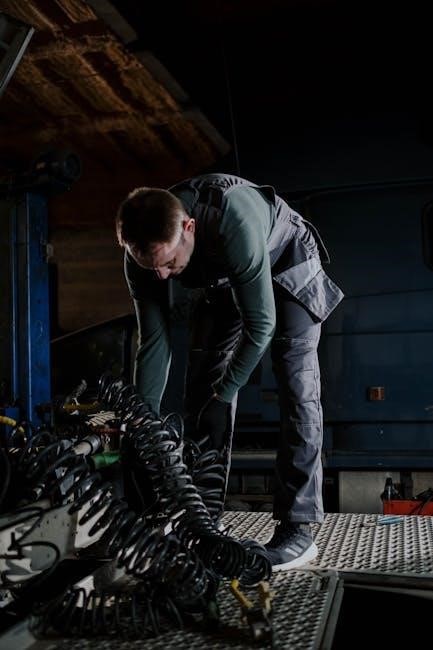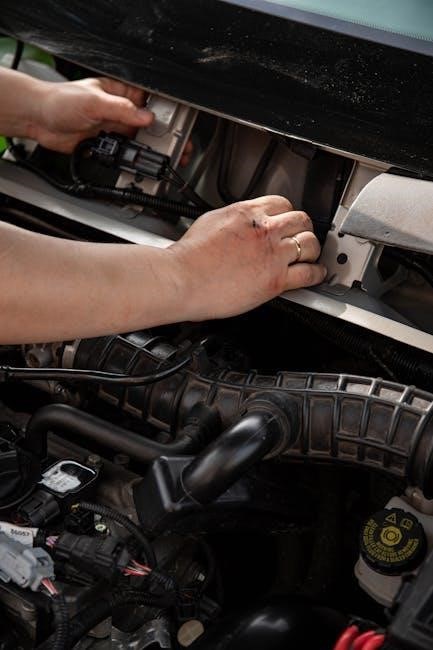The Cessna 172P Parts Manual is a comprehensive guide detailing components‚ maintenance procedures‚ and troubleshooting for the aircraft‚ ensuring optimal performance and safety.
1.1 Overview of the Cessna 172P Aircraft
The Cessna 172P Skyhawk is a widely used single-engine‚ four-seat aircraft renowned for its reliability and ease of handling. Produced by Cessna Aircraft Company‚ it features a Lycoming O-320-H2AD engine‚ delivering robust performance for training and personal flying. Its design emphasizes durability‚ with a sturdy airframe and straightforward systems. The 172P model includes advanced avionics‚ such as the Garmin G1000 suite‚ enhancing navigation and safety. Known for its forgiving flight characteristics‚ the aircraft is ideal for student pilots and experienced flyers alike. Its versatility allows operations from various airstrips‚ making it a popular choice globally. With a strong safety record and low operating costs‚ the Cessna 172P remains a cornerstone in general aviation‚ suitable for both training and recreational purposes.
1.2 Importance of the Parts Manual for Maintenance and Repair
The Cessna 172P Parts Manual is essential for ensuring the aircraft’s airworthiness and safety. It provides detailed diagrams and part numbers‚ enabling mechanics to identify and replace components accurately. Regular maintenance requires referencing this manual to adhere to Federal Aviation Regulations (FARs) and Airworthiness Directives (ADs). Proper use of the manual helps prevent installation errors‚ reducing the risk of system failures. It also guides troubleshooting‚ allowing technicians to diagnose and resolve issues efficiently. By following the manual‚ maintenance teams can extend the aircraft’s service life and maintain its performance. Compliance with the manual’s instructions is crucial for legal and safety standards‚ ensuring the Cessna 172P operates reliably and safely for years to come.

Airframe Components
The Cessna 172P airframe consists of the fuselage‚ wings‚ control surfaces‚ and landing gear‚ each designed for durability and aerodynamic efficiency‚ ensuring structural integrity and flight performance.
2.1 Fuselage and Wing Structures
The Cessna 172P’s fuselage is constructed from durable aluminum alloys‚ providing structural integrity and lightweight performance. The wing structure‚ featuring a cantilever design‚ is reinforced with internal spars and ribs for strength. The wingspan measures 36 feet 1 inch‚ with a total area of 174 square feet. The fuselage houses the cockpit‚ passenger seating‚ and cargo areas‚ while the wings are equipped with fuel tanks and control surfaces. Regular inspection of these components is critical to ensure airworthiness. Maintenance practices include checking for corrosion‚ damage‚ or wear on rivets and seams. Proper alignment and secure attachment of wings to the fuselage are essential for safe operation. The parts manual details specifications for replacement parts and repair procedures to maintain structural integrity and performance. Adhering to these guidelines ensures the aircraft remains safe and efficient for flight operations.
2.2 Control Surfaces (Ailerons‚ Elevators‚ Rudder)
The Cessna 172P’s control surfaces‚ including ailerons‚ elevators‚ and rudder‚ are essential for precise flight control. Ailerons‚ located on the trailing edges of the wings‚ manage roll‚ while elevators on the horizontal stabilizer control pitch. The rudder‚ on the vertical stabilizer‚ governs yaw. Constructed from durable aluminum‚ these surfaces are designed for longevity and responsiveness. Regular inspections are critical to ensure proper function‚ focusing on hinge alignment‚ cable connections‚ and absence of damage. The parts manual provides detailed specifications for repairs and replacements‚ ensuring optimal performance. Proper maintenance of these components is vital for maintaining aircraft stability and responsive handling during various flight conditions. Their precise operation is crucial for safe and efficient flight operations‚ making them a focal point of routine inspections and maintenance protocols.
2.3 Landing Gear and Brake Systems
The Cessna 172P features a durable‚ fixed tricycle landing gear system designed for stability and reliability. The main landing gear‚ equipped with wheels and brakes‚ absorbs impact during landings‚ while the nose gear ensures smooth taxiing. Hydraulic brakes‚ actuated by foot pedals‚ provide precise control for stopping. Regular inspections of the landing gear and brake systems are essential to ensure proper function and safety. The parts manual specifies maintenance intervals‚ lubrication requirements‚ and replacement procedures for components like brake pads‚ wheels‚ and actuators. Proper alignment and functionality of these systems are critical for safe ground operations‚ making them a priority in routine maintenance checks. The manual also outlines troubleshooting steps for common issues‚ ensuring optimal performance and longevity of the landing gear and brake systems.

Engine and Propeller
The Cessna 172P is powered by a Lycoming O-320-H2AD engine‚ producing 160 horsepower. It features a fixed-pitch‚ aluminum propeller. The parts manual details engine specifications‚ propeller operation‚ and maintenance procedures to ensure optimal performance and longevity.
3.1 Lycoming O-320-H2AD Engine Specifications
The Lycoming O-320-H2AD engine powers the Cessna 172P‚ delivering a maximum of 160 horsepower at 2‚400 RPM. Designed for reliability‚ it features a four-cylinder‚ air-cooled configuration with a displacement of 320 cubic inches. The engine utilizes a direct-drive system‚ eliminating the need for a gearbox‚ and operates on 100LL avgas. Its robust design ensures consistent performance across various flight conditions. Key specifications include a compression ratio of 8.5:1‚ a fuel injection system‚ and a maximum oil capacity of 8 quarts. Regular adherence to maintenance schedules ensures optimal performance and longevity. Compliance with Airworthiness Directives (ADs) is crucial for operational safety. This engine’s proven track record makes it a cornerstone of the Cessna 172P’s reliability and efficiency.
3.2 Propeller Types and Maintenance
The Cessna 172P typically features a fixed-pitch or constant-speed propeller‚ each designed for specific performance needs. Fixed-pitch propellers are simpler‚ offering consistent performance‚ while constant-speed models adjust pitch for optimal efficiency across varying conditions. Regular maintenance is critical‚ including inspections for cracks‚ erosion‚ or damage. Propeller balancing and blade repairs must adhere to manufacturer guidelines. Lubrication of hub components and pitch-control mechanisms is essential. Compliance with Airworthiness Directives (ADs) ensures safety and airworthiness. Proper maintenance extends propeller life‚ enhances performance‚ and prevents costly repairs. Always refer to the official Cessna documentation for detailed procedures and specifications‚ ensuring compliance with Federal Aviation Regulations (FARs).

Avionics and Electrical Systems
The Cessna 172P features the Garmin G1000 avionics suite‚ integrating navigation‚ communication‚ and flight instruments. The electrical system includes batteries‚ alternators‚ and circuit breakers‚ ensuring reliable power distribution essential for modern avionics functionality and safety.
4.1 Garmin G1000 Avionics Suite Overview
The Garmin G1000 is an advanced avionics system integrated into the Cessna 172P‚ offering a glass cockpit experience with a primary flight display (PFD) and multi-function display (MFD). It combines navigation‚ communication‚ and flight control systems into a user-friendly interface. The G1000 features a high-resolution display‚ providing pilots with critical flight data‚ including altitude‚ airspeed‚ heading‚ and navigation information. It also supports advanced features like autopilot functionality‚ weather radar‚ and terrain awareness. The system streamlines cockpit operations‚ reducing pilot workload and enhancing situational awareness. With its intuitive design‚ the G1000 has become a cornerstone of modern avionics‚ making it easier for pilots to navigate and manage flight operations safely and efficiently.
4.2 Electrical System Components (Batteries‚ Alternators‚ Circuit Breakers)

The Cessna 172P’s electrical system is essential for powering avionics‚ lights‚ and other critical systems. The system includes a 12-volt lead-acid battery‚ which provides power when the engine is off. The alternator charges the battery and supplies electricity during engine operation. Circuit breakers protect the electrical circuits from overloads‚ ensuring safe and reliable operation. Regular maintenance‚ such as checking battery voltage and alternator belts‚ is crucial to prevent electrical failures. Proper functioning of these components is vital for the aircraft’s avionics‚ including the Garmin G1000‚ ensuring that all systems operate efficiently and safely during flight.

Flight Instruments and Controls
The Garmin G1000 suite provides primary flight instruments like altimeter‚ airspeed‚ and heading indicators. Navigation tools include GPS‚ VOR‚ and ADF. Controls such as yoke‚ throttle‚ and mixture enable precise flight management.
5.1 Primary Flight Instruments (Altimeter‚ Airspeed Indicator‚ Heading Indicator)
The primary flight instruments in the Cessna 172P are essential for safe and efficient flight operations. The altimeter provides critical altitude information‚ enabling pilots to navigate safely through various flight levels. The airspeed indicator displays the aircraft’s speed‚ crucial for maintaining optimal performance during takeoff‚ climb‚ and landing. Additionally‚ the heading indicator offers directional guidance‚ aligning the aircraft with the desired course. These instruments are strategically placed on the instrument panel for quick reference‚ ensuring pilots can monitor flight parameters effectively. Their accuracy and reliability are vital for maintaining control and situational awareness during all phases of flight.
Regular calibration and maintenance of these instruments are necessary to ensure their performance remains consistent and reliable. Pilots rely heavily on these tools to make informed decisions‚ making them indispensable for safe and successful flights.
5.2 Navigation Instruments (GPS‚ VOR‚ ADF)
The Cessna 172P is equipped with advanced navigation instruments to enhance situational awareness and precise flight routing. The GPS system provides precise location data‚ enabling accurate navigation and waypoint management. The VOR (VHF Omnidirectional Range) receiver allows pilots to determine their position relative to ground-based VOR stations‚ ensuring reliable enroute navigation. Additionally‚ the ADF (Automatic Direction Finder) aids in locating non-directional beacons‚ such as those associated with airports or other landmarks. These instruments integrate seamlessly with the aircraft’s avionics‚ offering pilots a comprehensive navigation solution. Regular maintenance and calibration of these systems are critical to ensure accuracy and compliance with Federal Aviation Regulations (FARs). Together‚ they enhance the safety and efficiency of flight operations.
5.3 Flight Controls (Yoke‚ Throttle‚ Mixture‚ Carburetor Heat)
The Cessna 172P features a robust set of flight controls designed for precise aircraft management. The yoke serves as the primary control for pitch and roll‚ directly connected to the ailerons and elevators. The throttle regulates engine power‚ controlling the propeller pitch for optimal performance during various flight phases. The mixture control adjusts the fuel-air ratio‚ ensuring efficient combustion at different altitudes. The carburetor heat system prevents ice formation in the carburetor by redirecting warm air‚ maintaining smooth engine operation. These controls are ergonomically designed for intuitive operation‚ allowing pilots to maintain smooth and precise control of the aircraft. Proper use of these systems is essential for safe and efficient flight‚ making them a focal point in pilot training and aircraft handling.

Maintenance and Troubleshooting
This section outlines routine inspections‚ diagnostic techniques‚ and repair procedures to ensure the aircraft’s airworthiness and address common issues promptly‚ adhering to safety standards and compliance requirements.
6.1 Routine Maintenance Procedures
Routine maintenance is essential for ensuring the Cessna 172P operates safely and efficiently. Regular checks include inspecting control surfaces‚ lubricating moving parts‚ and monitoring fluid levels. Pre-flight inspections should focus on the condition of tires‚ brakes‚ and propeller blades. The engine oil level and filtration system must be checked frequently to prevent contamination. Additionally‚ the landing gear and brake systems require periodic lubrication to maintain proper function. Propeller inspections should be conducted every 100 hours of flight time to identify wear or damage. Compliance with Airworthiness Directives (ADs) is critical to address potential safety issues. By adhering to these procedures‚ operators can extend the aircraft’s lifespan and ensure reliable performance. Proper documentation of all maintenance activities is also mandatory for regulatory compliance.

6.2 Common Issues and Solutions
Common issues with the Cessna 172P include engine oil leaks‚ particularly around the Lycoming O-320-H2AD engine‚ which require immediate attention to prevent damage. Garmin G1000 avionics glitches can occur‚ often resolved by restarting the system or updating software. Landing gear wear‚ especially on the nosegear‚ is frequent and should be monitored for damage. Tire pressure fluctuations are another issue‚ necessitating regular checks to ensure proper inflation. Carburetor icing can cause engine performance issues‚ addressed by using carburetor heat; Propeller de-icing is essential in cold climates to maintain efficiency. These problems‚ while common‚ can be effectively managed with timely inspections and adherence to maintenance protocols‚ ensuring the aircraft remains airworthy and reliable. Proper documentation of repairs is also crucial for tracking and preventing future issues.

Legal and Regulatory Compliance
Adherence to Airworthiness Directives and Federal Aviation Regulations (FARs) is crucial for the Cessna 172P. Compliance ensures safety and legal operation‚ with regular inspections and proper documentation required.
7.1 Airworthiness Directives (ADs) Compliance
Airworthiness Directives (ADs) are regulatory requirements issued by aviation authorities to address unsafe conditions in aircraft. For the Cessna 172P‚ compliance with ADs is mandatory to ensure the aircraft remains airworthy and safe for operation. ADs often specify inspections‚ modifications‚ or replacements of specific parts to prevent potential failures. Pilots and maintenance personnel must regularly review and implement these directives‚ referencing the parts manual for guidance on affected components. Proper documentation of AD compliance is essential for maintaining legal flight status. Failure to adhere to ADs can result in grounding of the aircraft until compliance is verified. Staying updated on the latest ADs is critical‚ as new directives are issued periodically to address emerging safety concerns. Always consult official Cessna documentation and FAA resources for the most accurate information. Timely compliance ensures continued safety and regulatory adherence.
7.2 Federal Aviation Regulations (FARs) Relevant to Parts Replacement
Federal Aviation Regulations (FARs) provide the legal framework for aircraft parts replacement‚ ensuring safety and compliance. For the Cessna 172P‚ FARs dictate the use of approved parts‚ proper documentation‚ and adherence to maintenance standards. Replacement parts must meet FAA-approved design and airworthiness standards‚ and all installations must be documented in the aircraft’s maintenance records. FARs also specify requirements for return-to-service inspections after parts replacement. Compliance with these regulations is mandatory to maintain the aircraft’s airworthiness certification. Additionally‚ FARs outline the responsibilities of mechanics and pilots in ensuring that all parts replacements are performed correctly and safely. Reference FAA publications‚ such as FAR 21 and FAR 43‚ for detailed guidance on parts replacement and maintenance procedures. Adhering to FARs ensures the aircraft remains safe for operation and compliant with federal aviation laws. Proper compliance is essential for avoiding legal issues and maintaining flightworthiness. Always consult official FAA resources for the most accurate and up-to-date information.

Resources and References
The Cessna 172P parts manual directs users to official resources like the Pilot’s Operating Handbook (POH) and parts catalog. Online forums and communities offer additional support and troubleshooting advice.
8.1 Official Cessna Documentation and Manuals
Official Cessna documentation‚ including the Cessna 172P Parts Manual‚ provides detailed information on aircraft components‚ maintenance procedures‚ and compliance requirements. These manuals are essential for ensuring the aircraft’s airworthiness and operational safety. The Parts Manual specifically catalogs every component‚ offering part numbers‚ descriptions‚ and installation guidelines. Additionally‚ Cessna publishes Service Bulletins and Airworthiness Directives to address safety improvements and mandatory modifications. The Pilot’s Operating Handbook (POH) complements the Parts Manual by detailing flight procedures and performance specifications. These official documents are available through Cessna’s website‚ authorized distributors‚ or aircraft maintenance organizations. Proper use of these resources ensures adherence to Federal Aviation Regulations (FARs) and manufacturer recommendations‚ making them indispensable for owners‚ mechanics‚ and pilots. Regular updates to these manuals reflect ongoing improvements and regulatory changes‚ ensuring the aircraft remains safe and efficient.
8.2 Online Forums and Communities for Support
Online forums and communities provide invaluable support for understanding and utilizing the Cessna 172P Parts Manual. Platforms like Reddit’s r/aviation and specialized aviation forums offer spaces for pilots and mechanics to share experiences‚ ask questions‚ and troubleshoot issues. Websites such as AOPA (Aircraft Owners and Pilots Association) forums host discussions on maintenance‚ parts identification‚ and compliance with airworthiness directives. YouTube tutorials and videos often complement the manual‚ offering visual guides for complex procedures. These communities foster collaboration‚ helping users interpret technical specifications and resolve common challenges. While online resources are helpful‚ always verify advice with official Cessna documentation to ensure accuracy and compliance with safety standards. Engaging with these forums can enhance your understanding of the Cessna 172P Parts Manual and improve aircraft maintenance practices.